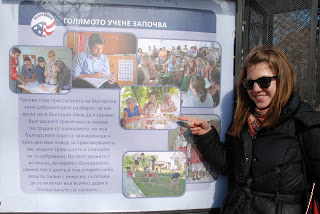Instead of celebrating, I am sitting on a bus heading back to Chiprovtsi from Sofia (again!). So absurd. The service project is 5 days away and I’ve spent the last two in Sofia-horrible timing. A friend drove me to Sofia in the Tuesday evening after my right hand swelled up huge in a couple hours time for no reason. I felt like I had one of those foam fingers seen at sports games on my hand. It wasn’t clear what the cause was initially and PC med staff wanted to make sure it wasn’t something awful.
One of their doctors took me to have tests and been seen by specialists in Tokuda Hospital-a new Japanese hospital in Sofia. Wow, such a nice hospital. Weird thing to notice, but the toilets there even have temperature settings for the seats and the bidet water. Anyways, my hand continued swelling and turning colors until midday Wednesday and then started to shrink. The tests came back normal and it was concluded to be an allergic reaction to something like a bug or plant. I’m so grateful to be heading back to site…though I did enjoy going out for sushi and falafel while in Sofia…still, really terrible timing for something like this to happen.
I’m so nervous about Tuesday. I began working on the composting idea in the fall, but it was put on hold through the winter as different projects took priority. The idea of a kick-off party combined with a Mardi Gras celebration seemed like a good idea to re-energize the project and put the holiday décor care packages to good use. My colleagues agreed and I signed us up for the first event in Peace Corps Bulgaria’s 20 Days of Service. [The 20 Days of Service are 20 different events organized by PC volunteers around Bulgaria from now to the end of the year to highlight 20 years of service].
Well…since signing us up, a few things have changed. The date was shifted to the 22nd to better accommodate partner organizations; then, because the 22nd is also World Water Day and the school usually has a spring carnivale around this time-it was decided these should all be combined. For me, this sounds great, the more people and groups involved the better the outcome. But I’m struggling with my very American desire to have a finished action plan with itinerary, task list, activity owners, etc. There will be 100 kids from 1st-8th grade, expecting a composting-carnivale-world water-environment-spring day and I am so worried about letting them down.
I know I shouldn’t be too concerned, my colleagues in the Municipality are fantastic – they organized the summer camp in August, the kids are patient good kids, and the school has enthusiastic, involved teachers, but still. What if my plan takes 15 minutes and then nothing? I don’t have any clue what to do? Tsetska and I went to the school on Tuesday morning (before the foam finger weirdness) and presented composting to all of the classes. I had hoped to spend the past few days in the school, helping with the student’s preparation and encouraging involvement, but this, clearly did not occur.
I have to keep reminding myself of the analogy presented during one of our training sessions about the general working styles in America and Bulgaria. I don’t know if I mentioned this before, but even if I did, I think it’s worthwhile, at least for my own peace of mind, to write about again. The American approach to project planning is like the approach to preparing an orchestra for a symphony whereas the Bulgarian approach is like preparing for a live jazz concert. In getting ready for a symphony, the outcome is already known, a conductor leads, musicians have specific roles in the composition and are provided with practice material to perfect. The result comes from practiced instruments playing the correct notes at the correct moment, thus fulfilling a composer’s intent. In the same way, Americans tend to approach project planning with an expected outcome, assigned tasks, deadlines, and success measured by how well the predetermined objectives were achieved.
In contrast, a jazz concert, equally as beautiful comes about organically. There are instruments and a general idea of what will come about, but the beauty of jazz comes from the way the musicians respond to each other and the audience in the moment. Growing, reacting, and adjusting to the environment as it changes. In this way, our presenter said, Bulgarian project planning tends to produce results, but with much less emphasis on the ‘planning.’ We worry because we’ve only played in symphonies before, where practice and a sheet music are indispensable. The Bulgarians already know how to play their instruments and, like with live jazz, you can’t prepare for where the music will take you, but should be confident that the outcome will still be beautiful.


























